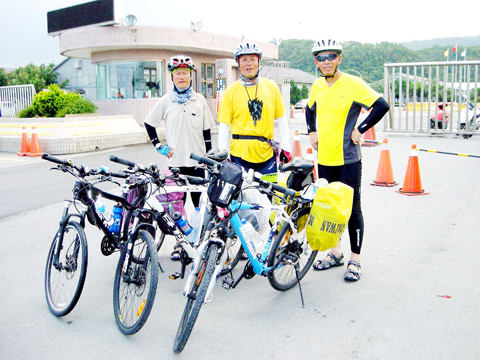Most radiation that humans come into contact with exists naturally in the environment and is harmless to human health, the Atomic Energy Council (AEC) said yesterday, adding that people should not be overly concerned about radiation hazards in their daily lives.
Last month, three AEC employees spent 10 days traveling around the country on their bikes. Five flat tires, two falls into gutters and some 300 or more radiation checks later, the trio returned to Taipei with data showing that radiation levels nationwide are within safety levels, AEC Radiation Monitoring Center director Huang Ching-chung (黃景鐘) said.
“Two-thirds of the radiation people experience in life exists in the environment naturally, while another third comes from medical treatments such as X-rays or MRI scans,” Huang said.

PHOTO: CNA
Radiation coming from nuclear plants or other nuclear devices combined contributes to less than 1 percent of total radiation, he added.
What is also important to know is that radiation — measured in alpha, beta or gamma rays — produces the same effect on human bodies despite its source, Huang said.
For example, cosmic gamma rays would have the same effect on the body as gamma rays produced by a nuclear plant, he said.
In terms of the radiation levels measured by the three bikers, “the highest gamma ray dose was 0.050 microsieverts per hour (μSv/h), measured on the Northern Cross-Island Highway (北橫公路), while the lowest was 0.023 μSv/h around Hualien,” Huang said.
“However, even if one looks at the ‘double’ amount, in reality they are both far below the 0.2 μSv/h safety level published by the AEC, and the differences should be regarded as insignificant and ascribed to natural variations,” he said.
The same conclusion also applies to areas to which the bikers did not trek, such as high mountains, where radiation levels are naturally stronger.
“Three major sources contribute to natural ionizing radiation in the environment — cosmic rays, gamma rays from the earth and sources in the atmosphere including radon gas,” Huang said.
Cosmic rays are stronger in higher latitudes, thereby strongest at the North Pole, Huang said, adding that high altitude regions atop mountains like Alishan are also affected more strongly by the rays.
But as the nation as a whole has a low level of radiation, the place with the “highest radiation” is not scientifically meaningful, and the public should not panic and avoid hiking even if the radiation level is above 0.2μSv/h, Huang said,
Citing the world’s four areas with the strongest levels of natural background radiation — Brazil’s Guarapari, China’s Yangjiang, India’s Kerala and Iran’s Ramsar — Huang said that while Guarapari is a prime tourist destination drawing crowds of visitors with its natural mud baths, major studies conducted in Yangjiang have found that nearby residents suffer from no long-term health maladies because of the radiation.
“The dose of natural background radiation in those places is hundreds of times higher than the 0.2 μSv/h level,” Huang said.

An essay competition jointly organized by a local writing society and a publisher affiliated with the Chinese Communist Party (CCP) might have contravened the Act Governing Relations Between the People of the Taiwan Area and the Mainland Area (臺灣地區與大陸地區人民關係條例), the Mainland Affairs Council (MAC) said on Thursday. “In this case, the partner organization is clearly an agency under the CCP’s Fujian Provincial Committee,” MAC Deputy Minister and spokesperson Liang Wen-chieh (梁文傑) said at a news briefing in Taipei. “It also involves bringing Taiwanese students to China with all-expenses-paid arrangements to attend award ceremonies and camps,” Liang said. Those two “characteristics” are typically sufficient

A magnitude 5.9 earthquake that struck about 33km off the coast of Hualien City was the "main shock" in a series of quakes in the area, with aftershocks expected over the next three days, the Central Weather Administration (CWA) said yesterday. Prior to the magnitude 5.9 quake shaking most of Taiwan at 6:53pm yesterday, six other earthquakes stronger than a magnitude of 4, starting with a magnitude 5.5 quake at 6:09pm, occurred in the area. CWA Seismological Center Director Wu Chien-fu (吳健富) confirmed that the quakes were all part of the same series and that the magnitude 5.5 temblor was

The brilliant blue waters, thick foliage and bucolic atmosphere on this seemingly idyllic archipelago deep in the Pacific Ocean belie the key role it now plays in a titanic geopolitical struggle. Palau is again on the front line as China, and the US and its allies prepare their forces in an intensifying contest for control over the Asia-Pacific region. The democratic nation of just 17,000 people hosts US-controlled airstrips and soon-to-be-completed radar installations that the US military describes as “critical” to monitoring vast swathes of water and airspace. It is also a key piece of the second island chain, a string of

The Central Weather Administration has issued a heat alert for southeastern Taiwan, warning of temperatures as high as 36°C today, while alerting some coastal areas of strong winds later in the day. Kaohsiung’s Neimen District (內門) and Pingtung County’s Neipu Township (內埔) are under an orange heat alert, which warns of temperatures as high as 36°C for three consecutive days, the CWA said, citing southwest winds. The heat would also extend to Tainan’s Nansi (楠西) and Yujing (玉井) districts, as well as Pingtung’s Gaoshu (高樹), Yanpu (鹽埔) and Majia (瑪家) townships, it said, forecasting highs of up to 36°C in those areas